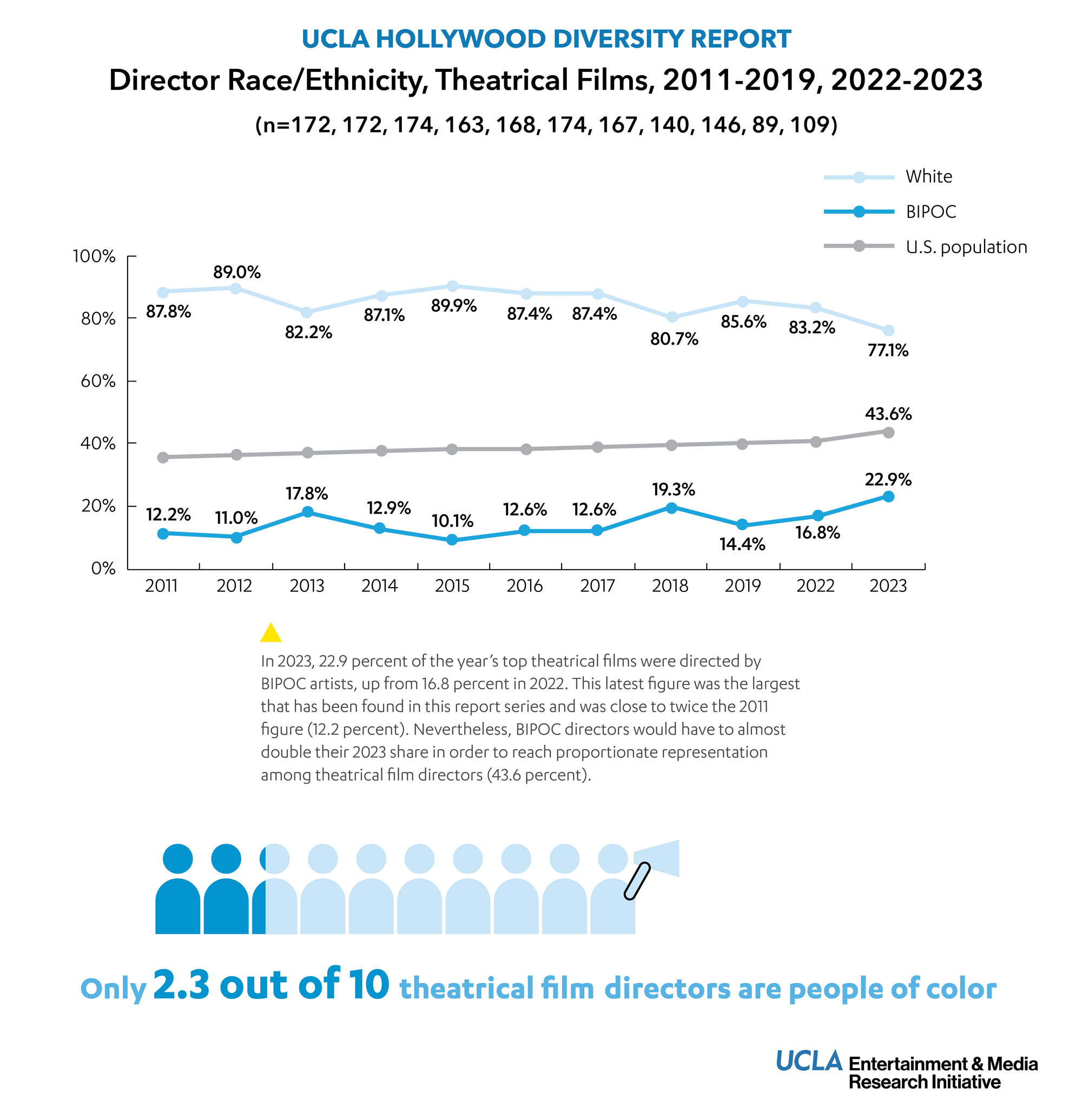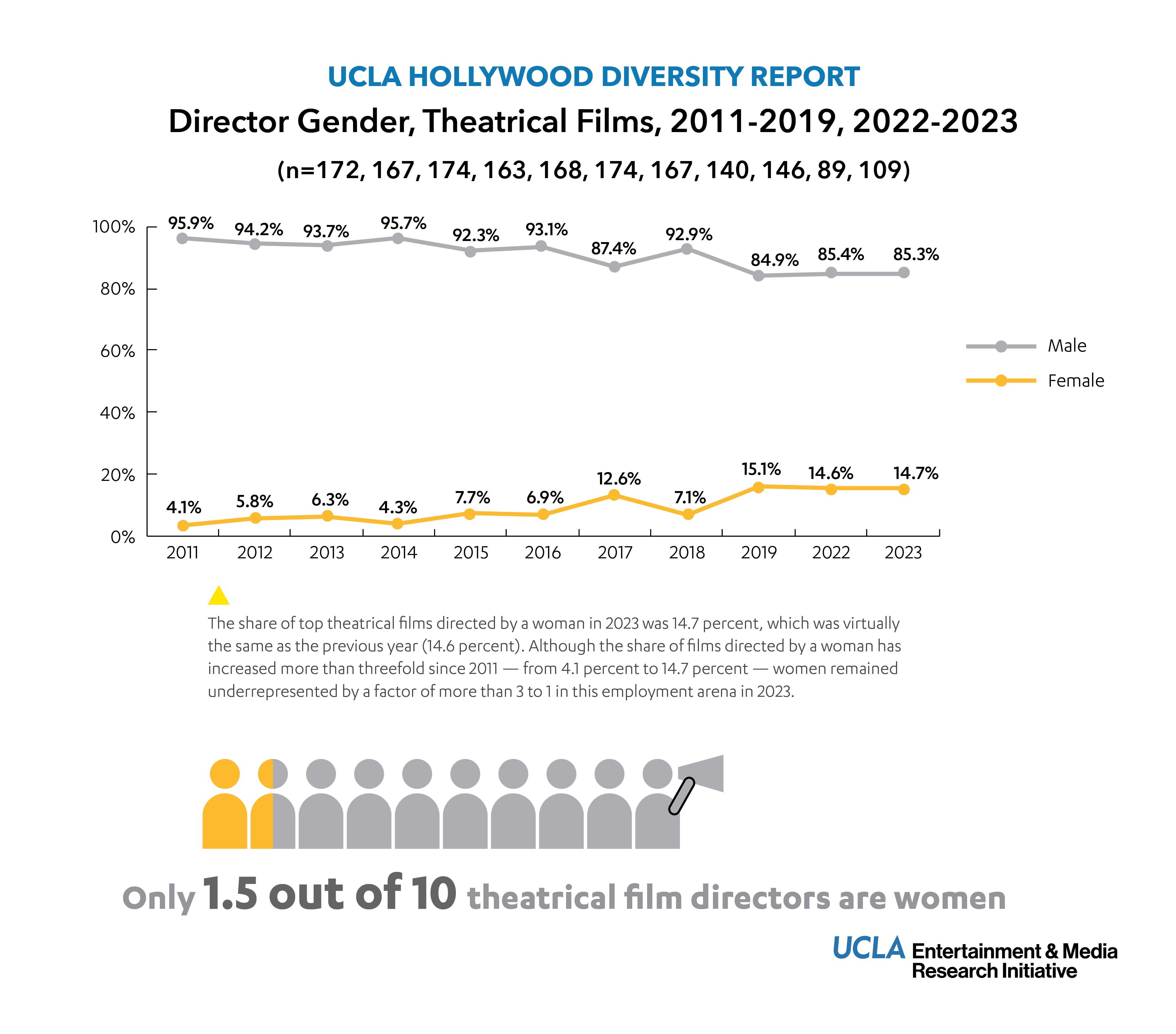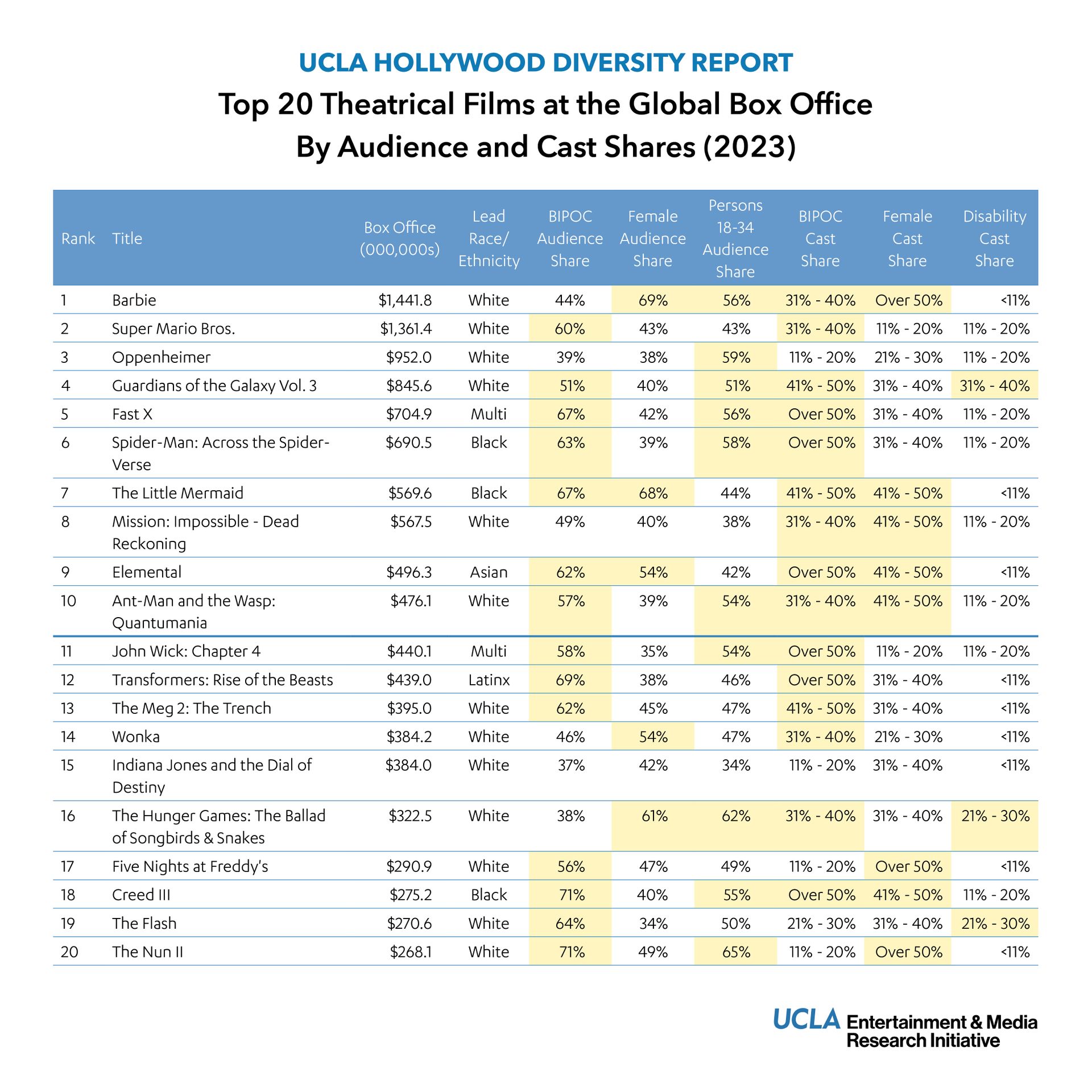Barbra Ramos, UCLA

Audiences of color and women drove the biggest box-office winners last year, propping up a film industry desperate to get back to pre-pandemic numbers, according to the latest Hollywood Diversity Report.
As the industry looks to recover from the pandemic and strikes by the Writers Guild of America and the Screen Actors Guild-American Federation of Television and Radio Artists, researchers point to box-office returns for films with diverse casts as the way out of the current theatrical downturn. Releases such as “Barbie” and “The Hunger Games: The Ballad of Songbirds & Snakes,” whose casts included 31 percent to 40 percent people of color, had the highest median global box-office earnings ($119.8 million) among the top 200 films of the year, the report found. Films like these were released more widely and earned more money than their counterparts.
“After examining global and domestic box-office success and audience demographics for more than a decade, we have repeatedly found that people want to see films that reflect the diversity that exists in their communities and in the world,” said Ana-Christina Ramón, co-founder of the report and director of UCLA’s Entertainment and Media Research Initiative.
Now in its 11th year of providing annual analyses of movies, television and audiences, the Hollywood Diversity Report reiterated the importance of diverse audiences to the movie industry’s aspirations for a comeback in this latest release, which covers the top English-language theatrical films of 2023. It offers an in-depth breakdown of who showed up to the theaters, what they chose to see and the people behind those hits. UCLA researchers also included detailed data and trends on race and ethnicity, gender and disability status around key job categories.
“Our reports can’t emphasize this enough: Films that embrace diversity are more likely to resonate with audiences, leading to box-office success and ultimately long-term sustainability for the industry,” said Darnell Hunt, UCLA’s executive vice chancellor and provost, and co-founder of the report.
People of color gain ground, hit historic series highs in key employment categories
Although people of color remained underrepresented on every major industry employment front in 2023, there were still notable milestones.
Representation for lead actors, total actors, directors and writers of color rose to the largest shares in each of those categories for top theatrical films in the report’s 11-year history.
The year marked another high as the share of theatrical films directed by people of color hit 22.9 percent, up 6 percentage points from last year and nearly double the 2011 figure.

Also for the first time, top films featuring cast diversity over 50 percent — the report’s most diverse interval — outnumbered less-diverse films, with a plurality at 26.4 percent.
Filmmakers of color are key to driving diversity in casts. Nearly 90 percent of films had racially and ethnically diverse casts when a filmmaker of color helmed the production.
Researchers emphasized that these highs cannot be analyzed in a vacuum, pointing especially to efforts and promises made by the studios in 2020 following the murder of George Floyd.
“The question is if this upward trend of diversity will continue,” Hunt said. “These gains are most likely a result of the projects greenlit three years ago. We’re in a very different and politicized place, and as the efforts and executives who championed inclusivity and equity disappear from studios, will the next three to five years show a freefall in terms of diversity in Hollywood?”
The “Barbie” effect — or bubble?
“Barbie,” the No. 1 film of 2023, made over $1.4 billion dollars at the global box office. It grossed $162 million during its opening weekend, a record for a female director and a record for a non-superhero film or sequel.
Key to its opening weekend success were women, who packed theaters and made up almost 70 percent of its domestic ticket sales.
But even as “Barbie” broke box-office records, the industry demonstrated it continued to undervalue movies centering on and led by women, as women lost ground when it came to representation for theatrical leads, writers and total actors.
“This is a wake-up call for Hollywood,” Ramón said. “Studios need to invest in women and their stories. Women creators and moviegoers are integral to the industry’s growth.”
Though the share of films directed by a woman has increased three-fold compared to 2011, it showed almost no progress when compared to last year, at 14.7 percent of all films.

Men held on to the most opportunities and the highest budgets when it came to directing. Only 16 films out of the top 200 were directed by women. Five of these were directed by women of color.
Films directed by white women were also the most likely to have the smallest budgets. “Barbie” was only one of three releases directed by a woman with a budget of $100 million or more, compared to 25 that were helmed by men.
“There’s an industrywide commitment problem with diversity,” said Hunt, who is also a professor of sociology and African American studies at UCLA.
Diversity in demand
The report found that film franchises got a boost when embracing diversity. “Creed III,” “Scream VI” and “John Wick: Chapter 4,” which featured lead actors of color and casts with 50 percent or more actors of color, posted the highest earnings in their film series. Audiences of color showed up, making up at least 60 percent of each film’s opening weekend domestic audience.
“When the film industry gives them what they want, people of color deliver at the box office year in and year out,” Ramón said.
Case in point: For seven of the top 10 films ranked by global box-office receipts, people of color bought the majority of opening weekend domestic tickets, filling the seats for hits like “Fast X” and “Spider-Man: Across the Spider-Verse.” Women also showed up in a major way for three films in the top 10, accounting for 69 percent of opening weekend domestic sales for “Barbie,” 68 percent for “The Little Mermaid” and 54 percent for “Elemental.”
When examining the top films for certain demographic audiences (ranked by each demographic group’s share of opening weekend at the domestic box office), the data found that the preferences of audiences of color were more in tune with overall box-office success. At least half, if not more, of the top 10 titles for Black, Asian, Latinx and Native American and other moviegoers also earned the coveted No. 1 spot at the domestic box office during their opening weekend. In contrast, none of the top 10 theatrical films for white moviegoers achieved that same distinction. Expanded top 20 lists for each demographic group were also included for the first time in the report series.
Audiences even pushed these diverse films to become global hits. It’s a point the authors emphasize that studios need to remember.
“Diversity sells here and overseas,” said co-author and UCLA doctoral candidate Michael Tran. “It’s the opposite of the conventional myth; the least diverse films performed the worst, and even posted a negative return on the studio’s investment.”
At both the global and domestic box office, the highest median earnings peak ($119.8 million and $58.4 million, respectively) was reached by films that had 31 percent to 40 percent actors of color in their main casts, such as “Killers of the Flower Moon” and “Wonka.” Both globally and domestically, the second-highest median box-office performance was found among films with casts that were 41 percent to 50 percent people of color, such as “The Little Mermaid” and “Guardians of the Galaxy Vol. 3.”

Nine of the top 10 films globally featured casts that were more than 30 percent people of color, and half of the top 10 films included casts that were more than 40 percent women. The report also notes that one of the top 10 and three of the top 20 films in 2023 featured a cast where more than 20 percent of the actors had a known disability.
The researchers emphasized that Hollywood needs to prioritize investing in diversity in front of and behind the camera.
“At this point, it seems more financially risky to reverse course and roll back the incremental progress the film industry has made on diversity and inclusion,” Ramón said. “Making a substantial investment in creatives from diverse backgrounds should be a clear business priority. It may be the only way the industry can sustain itself now and into the future.”
The report analyzed the English-language theatrical releases for 2023 among the top 200 films, determined by global box-office receipts. The resulting dataset of 109 films represented a 22 percent increase from the number of 2022 films that met the same criteria (91) but was much lower than the 146 examined for 2019.
The next release in the Hollywood Diversity Report series will analyze the streaming films of 2023.
More data on diversity in 2023 theatrical films
-
Key audience of 18- to 34-year-olds also watches diverse films. These moviegoers accounted for the majority of ticket sales for six of the top 10 and half of the top 20 films. Ten of their top 20 films featured diverse casts (more than 30 percent people of color), while eight of their top 10 featured more gender-balanced casts (more than 40 percent female). Additionally, another top 10 film for this audience was a Black-female-led music documentary (“Renaissance: A Film By Beyoncé”).
-
Actors with disabilities gained ground in shares of all theatrical roles (7.1 percent) and as leads (11.3 percent), up around 2 percentage points from last year. However, there were no lead actors with visible disabilities in the top films. Comprising at least 26 percent of the United States population, adults with a disability, especially visible disabilities, remained underrepresented in front of the camera in top films in 2023.
-
Lack of Native representation in top Hollywood films. There were zero Native leads in the top theatrical films of 2023, with only 10 Native actors counted among the top credited actors in the overall cast. None of the top films were directed or written by a Native person.
-
Latinx creators and creatives remain severely underrepresented. Among the top films, only five featured leads. Of the four Latinx writers and four Latinx directors in the top 200, none were women.

